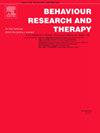在害怕蜘蛛的个体中,利用偶尔增强的厌恶图像来优化体内暴露。
IF 4.2
2区 心理学
Q1 PSYCHOLOGY, CLINICAL
引用次数: 0
摘要
虽然暴露疗法被广泛认为是治疗各种焦虑症的有效方法,但很大一部分患者在成功治疗后没有受益或经历恐惧的回归。一种有希望的策略是在消退过程中偶尔呈现引起恐惧的刺激(偶尔强化消退,ORE)。本研究探讨了一种将ORE转化为临床实践的新方法,通过结合个体在体内暴露时最糟糕的恐惧场景的偶尔生动图像。47名害怕蜘蛛的人被随机分配接受一次体内标准暴露治疗(Exp- only)或一次体内暴露治疗,并偶尔在心理上想象最糟糕的蜘蛛场景(Exp + ORE)。在治疗前和治疗后一周分别进行蜘蛛恐惧问卷调查和泛化行为方法测试。从基线到评估后,两组都有改善,但与标准暴露训练相比,Exp + ORE组在自我报告的对蜘蛛的恐惧和回避方面表现出明显更大的减少。在泛化行为接近测试中,所有参与者的主观痛苦和对蜘蛛的接近行为从基线到评估后都有显著改善,没有明显的组差异。研究结果还表明,与标准暴露相比,暴露期间偶尔的图像会导致更大的期望违反,这为ORE方法的潜在潜在机制提供了见解。将心理意象整合到偶尔强化的消退方法中,有望在临床环境中提高基于暴露的焦虑障碍治疗的疗效。本文章由计算机程序翻译,如有差异,请以英文原文为准。
Optimizing in vivo exposure using occasional reinforced extinction with aversive imagery in spider fearful individuals
Although exposure-based therapy is widely recognized as effective for treating various anxiety disorders, a significant proportion of patients fail to benefit or experience a return of fear following successful treatment. One promising strategy involves occasional presentation of fear-evoking stimuli during extinction (occasional reinforced extinction, ORE). This study investigates a novel approach to translate ORE into clinical practice by incorporating occasional vivid imagery of individuals' worst-case fear scenarios during in-vivo exposure. Forty-seven spider-fearful individuals were randomly assigned to receive either a one-session in-vivo standard exposure treatment (Exp-Only) or an one-session in-vivo exposure treatment supplemented with occasional mental imagery of their worst-case spider scenario (Exp + ORE). Fear of spider questionnaires and a generalization behavioral approach test were administered prior to and one week after treatment. Both groups showed improvement from baseline to post-assessment, but the Exp + ORE group demonstrated significantly greater reductions in self-reported fear and avoidance of spiders compared to standard exposure training. During the generalization behavioral approach test, subjective distress and approach behavior toward the spider significantly improved from baseline to post-assessment in all participants, with no discernible group differences. Findings moreover indicate that occasional imagery during exposure lead to greater expectancy violation compared to standard exposure, providing insights into potential underlying mechanisms of the ORE approach. Incorporating mental imagery into the occasional reinforced extinction approach could hold promise for enhancing the efficacy of exposure-based treatments for anxiety disorders in clinical settings.
求助全文
通过发布文献求助,成功后即可免费获取论文全文。
去求助
来源期刊

Behaviour Research and Therapy
PSYCHOLOGY, CLINICAL-
CiteScore
7.50
自引率
7.30%
发文量
148
期刊介绍:
The major focus of Behaviour Research and Therapy is an experimental psychopathology approach to understanding emotional and behavioral disorders and their prevention and treatment, using cognitive, behavioral, and psychophysiological (including neural) methods and models. This includes laboratory-based experimental studies with healthy, at risk and subclinical individuals that inform clinical application as well as studies with clinically severe samples. The following types of submissions are encouraged: theoretical reviews of mechanisms that contribute to psychopathology and that offer new treatment targets; tests of novel, mechanistically focused psychological interventions, especially ones that include theory-driven or experimentally-derived predictors, moderators and mediators; and innovations in dissemination and implementation of evidence-based practices into clinical practice in psychology and associated fields, especially those that target underlying mechanisms or focus on novel approaches to treatment delivery. In addition to traditional psychological disorders, the scope of the journal includes behavioural medicine (e.g., chronic pain). The journal will not consider manuscripts dealing primarily with measurement, psychometric analyses, and personality assessment.
 求助内容:
求助内容: 应助结果提醒方式:
应助结果提醒方式:


